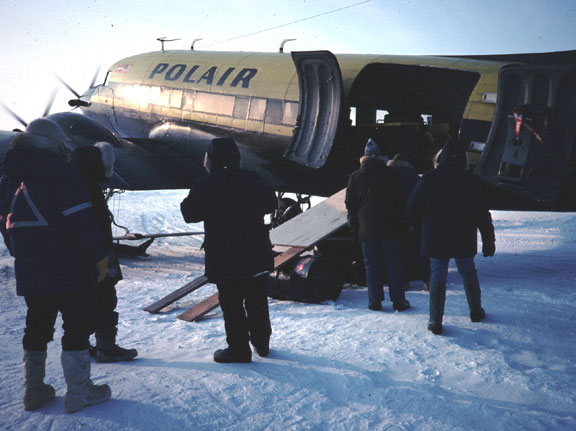
Tri-Turbo DC-3 Being Unloaded on the High-Arctic Ice Pack

In the 1980's I worked for TRW Space and Technology Group in Redondo Beach, California. Our group worked mainly on chemical rockets, high energy chemical lasers, and space technology. We did, however, secure a contract with the US Navy to develop an ice-penetrating communications buoy. The buoy was developed using TRW's proprietary penetration scheme and tested over a 5 year period.
Testing was conducted at TRW facilities and field demonstrations were conducted from 1984 through 1987 on the ice pack of the Beaufort Sea, the High Arctic and at the North Pole. These tests were held in conjunction with Navy sponsored field exercises. Three of these exercises were named AREA-84, AREA-85, and AREA-86 (Arctic Research and Environmental Acoustics). The field camps in the High Arctic were an impressive logistical undertaking and logistics were staged through Thule, Greenland (Thule Air Force Space Command) 1984 through 1985 and Thule and Danish Station Nord, Greenland in 1986. One of our trips in May of 1984 took us up to the Beaufort Sea off the coast of Barrow, Alaska through the former Navy Arctic Research Laboratory (NARL).
[More information on current Arctic Programs and Logistics]
To get to the High Arctic and North Pole Ice Camps we would first take a C-141 transport flown by the Air Force Reserve from McGuire Air Force Base in New Jersey to Thule, Greenland with stops in Goose Bay, Labrador and Sondrestrom, Greenland (also known as Søndre Strømfjord or now Kangerlussuaq). This took almost 12 hours. Thule was the logistical staging base for the Arctic ice camps. map of Arctic Region and locations of ice camps
In 1986, staging was at Thule and through the Danish Station
Nord, Greenland, primarily because the Tri-Turbo DC-3 aircraft that had been
used to supply the ice camps in previous years was damaged in a fire in Santa
Barbara, California. The Tri-Turbo was an old DC-3 aircraft modified by installing
three turboprop engines, one mounted on the nose of the aircraft. This gave
the aircraft the range and payload capabilities to make it to the North Pole
and back from Thule. The Tri-Turbo was designed by Conroy aviation, the same
group that built the "Super Guppy". The Super Guppy Aircraft was built to
transport sections of Werner Von Braun's giant Saturn V moon rocket in the
1960's.
tri turbo-polair site
DeHaviland Twin Otter aircraft were used in addition to the
Tri-Turbo.
ken borek air
In addition, a DeHaviland Caribou,
a Harold's Air DC-3, Air Force C-141 and C-130 aircraft were used during
parts of the exercises.
Getting to the Beaufort Sea was not quite as involved in 1984. Cargo was shipped up to Barrow Alaska and we took commercial aircraft from Anchorage, through Prudoe Bay to Barrow Alaska. Our ice camp up on the Beaufort Sea in 1984 was small enough and close enough to Barrow that a helicopter was sufficient for transportation. In later years the Navy had some large research camps in this region requiring much more involved logistics. The University of Washington's Applied Physics Laboratory was usually heavily involved in these Beaufort Sea exercises. APL's polar program
Establishment of the High Arctic Ice camps was similar each year. As soon as the sun came up at the Pole (March 21st), the first reconnaissance aircraft, usually the Tri-Turbo, would fly up to the desired region and look for a suitable ice floe to support the future ice camp. When a suitable location was found, supplies and food would be air dropped by parachute followed by two jumpers that would camp on the ice for about one week to prepare a suitable landing area for the Tri-Turbo or in later years a DeHaviland Twin Otter. One of these jumpers was always Kiwi born John "Jumper" Bitters, well known for his decades of work in the Arctic. Under contract with the Navy for much of the logistical support was Polar Research, Incorporated out of Santa Barbara headed by Beau Buck and his son Manor. The Tri-Turbo was usually flown by the late Giles Kershaw who later went on to create Adventure International with a base at Patriot Hills in Antarctica. He was killed in the early 1990's in an ultralight aircraft accident in Antarctica.
Once the landing site was prepared, the Tri-Turbo aircraft (in 1986, the Borek Twin Otter) made the initial landing and the construction of the temporary main ice camp began. Satellite camps were subsequently built and within the first week, scientists and additional logistical teams arrived to quickly set up and begin the research because the ice camp would be removed by mid May. After this time the weather and multi-year ice melt water would make operations too dangerous. This made the available time window only 2 short months.
I participated in the program from 1984 through 1986 and
each year there was a main camp and several satellite camps positioned in
locations from 86 degrees north latitude to 90 degrees north, at the pole.
The main camp usually had about 20 people and the satellite camps much less.
In 1986, however, the main camp, called Astrid, had over 40 people.